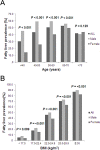External validation of fatty liver index for identifying ultrasonographic fatty liver in a large-scale cross-sectional study in Taiwan
- PMID: 25781622
- PMCID: PMC4363626
- DOI: 10.1371/journal.pone.0120443
External validation of fatty liver index for identifying ultrasonographic fatty liver in a large-scale cross-sectional study in Taiwan
Abstract
Background and aims: The fatty liver index (FLI) is an algorithm involving the waist circumference, body mass index, and serum levels of triglyceride and gamma-glutamyl transferase to identify fatty liver. Although some studies have attempted to validate the FLI, few studies have been conducted for external validation among Asians. We attempted to validate FLI to predict ultrasonographic fatty liver in Taiwanese subjects.
Methods: We enrolled consecutive subjects who received health check-up services at the Taipei Veterans General Hospital from 2002 to 2009. Ultrasonography was applied to diagnose fatty liver. The ability of the FLI to detect ultrasonographic fatty liver was assessed by analyzing the area under the receiver operating characteristic (AUROC) curve.
Results: Among the 29,797 subjects enrolled in this study, fatty liver was diagnosed in 44.5% of the population. Subjects with ultrasonographic fatty liver had a significantly higher FLI than those without fatty liver by multivariate analysis (odds ratio 1.045; 95% confidence interval, CI 1.044-1.047, p< 0.001). Moreover, FLI had the best discriminative ability to identify patients with ultrasonographic fatty liver (AUROC: 0.827, 95% confidence interval, 0.822-0.831). An FLI < 25 (negative likelihood ratio (LR-) 0.32) for males and <10 (LR- 0.26) for females rule out ultrasonographic fatty liver. Moreover, an FLI ≥ 35 (positive likelihood ratio (LR+) 3.12) for males and ≥ 20 (LR+ 4.43) for females rule in ultrasonographic fatty liver.
Conclusions: FLI could accurately identify ultrasonographic fatty liver in a large-scale population in Taiwan but with lower cut-off value than the Western population. Meanwhile the cut-off value was lower in females than in males.
Conflict of interest statement
Figures

Similar articles
-
External validation of the fatty liver index for identifying nonalcoholic fatty liver disease in a population-based study.Clin Gastroenterol Hepatol. 2013 Sep;11(9):1201-4. doi: 10.1016/j.cgh.2012.12.031. Epub 2013 Jan 22. Clin Gastroenterol Hepatol. 2013. PMID: 23353640
-
Validation of the Fatty Liver Index for Nonalcoholic Fatty Liver Disease in Middle-Aged and Elderly Chinese.Medicine (Baltimore). 2015 Oct;94(40):e1682. doi: 10.1097/MD.0000000000001682. Medicine (Baltimore). 2015. PMID: 26448014 Free PMC article.
-
Comparison of fatty liver index with noninvasive methods for steatosis detection and quantification.World J Gastroenterol. 2013 Jan 7;19(1):57-64. doi: 10.3748/wjg.v19.i1.57. World J Gastroenterol. 2013. PMID: 23326163 Free PMC article.
-
The accuracy of fatty liver index for the screening of overweight and obese children for non-alcoholic fatty liver disease in resource limited settings.BMC Pediatr. 2022 Aug 30;22(1):511. doi: 10.1186/s12887-022-03575-w. BMC Pediatr. 2022. PMID: 36042456 Free PMC article.
-
How good is controlled attenuation parameter and fatty liver index for assessing liver steatosis in general population: correlation with ultrasound.Liver Int. 2014 Jul;34(6):e111-7. doi: 10.1111/liv.12305. Epub 2013 Sep 4. Liver Int. 2014. PMID: 24034415
Cited by
-
Combining serum uric acid and fatty liver index to improve prediction quality of nonalcoholic fatty liver disease.Saudi J Gastroenterol. 2023 May-Jun;29(3):191-198. doi: 10.4103/sjg.sjg_484_22. Saudi J Gastroenterol. 2023. PMID: 36876619 Free PMC article.
-
Diagnostic Modalities of Non-Alcoholic Fatty Liver Disease: From Biochemical Biomarkers to Multi-Omics Non-Invasive Approaches.Diagnostics (Basel). 2022 Feb 4;12(2):407. doi: 10.3390/diagnostics12020407. Diagnostics (Basel). 2022. PMID: 35204498 Free PMC article. Review.
-
Metabolic Characteristics of a Novel Ultrasound Quantitative Diagnostic Index for Nonalcoholic Fatty Liver Disease.Sci Rep. 2019 May 28;9(1):7922. doi: 10.1038/s41598-019-44453-3. Sci Rep. 2019. PMID: 31138858 Free PMC article.
-
Higher fatty liver index is associated with increased risk of new onset heart failure in healthy adults: a nationwide population-based study in Korea.BMC Cardiovasc Disord. 2020 Apr 28;20(1):204. doi: 10.1186/s12872-020-01444-x. BMC Cardiovasc Disord. 2020. PMID: 32345225 Free PMC article.
-
Association of increased hepatic insulin clearance and change in serum triglycerides or β-hydroxybutyrate concentration via the sodium/glucose-cotransporter 2 inhibitor tofogliflozin.Diabetes Obes Metab. 2020 Jun;22(6):947-956. doi: 10.1111/dom.13980. Epub 2020 Feb 14. Diabetes Obes Metab. 2020. PMID: 31984623 Free PMC article. Clinical Trial.
References
-
- Lee JY, Kim KM, Lee SG, Yu E, Lim YS, Lee HC, et al. Prevalence and risk factors of non-alcoholic fatty liver disease in potential living liver donors in Korea: a review of 589 consecutive liver biopsies in a single center. J Hepatol 2007;47: 239–244. - PubMed
Publication types
MeSH terms
LinkOut - more resources
Full Text Sources
Other Literature Sources

